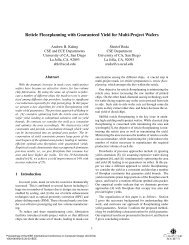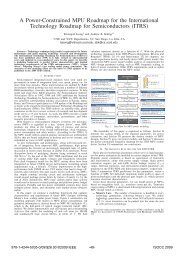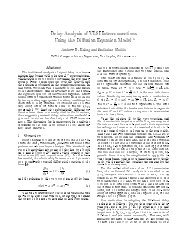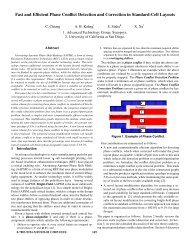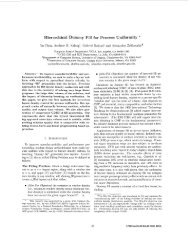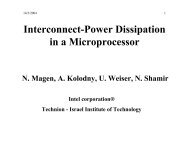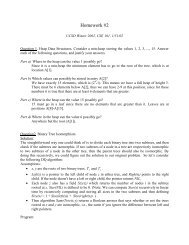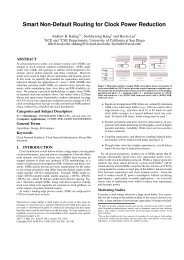Optimization of Linear Placements for Wirelength ... - CECS
Optimization of Linear Placements for Wirelength ... - CECS
Optimization of Linear Placements for Wirelength ... - CECS
Create successful ePaper yourself
Turn your PDF publications into a flip-book with our unique Google optimized e-Paper software.
<strong>Optimization</strong> <strong>of</strong> <strong>Linear</strong> <strong>Placements</strong> <strong>for</strong> <strong>Wirelength</strong> Minimization with Free Sites Andrew B. Kahng, Paul Tucker † and Alex ZelikovskyUCLA CS Department, Los Angeles, CA 90095-1596† UCSD CSE Department, La Jolla, CA, 92093-0114AbstractWe study a type <strong>of</strong> linear placement problem arising in detailed placementoptimization <strong>of</strong> a given cell row in the presence <strong>of</strong> white-space(extra sites). In this single-row placement problem, the cell order isfixed within the row; all cells in other rows are also fixed. We give thefirst solutions to the single-row problem: (i) a dynamic programmingtechnique with time complexity O(m 2 ) where m is the number <strong>of</strong> netsincident to cells in the given row, and (ii) an O(mlogm) techniquethat exploits the convexity <strong>of</strong> the wirelength objective. We also proposean iterative heuristic <strong>for</strong> improving cell ordering within a row;this can be run optionally be<strong>for</strong>e applying either (i) or (ii). Experimentalresults show an average <strong>of</strong> 6.5% wirelength improvement onindustry test cases when our methods are applied to the final output <strong>of</strong>a leading industry placement tool.1 IntroductionThe linear placement problem (LPP) is well-studied in the VLSIphysical design literature, where it has appeared in various guises[15, 10, 11, 6, 2, 9, 13]. Traditionally, linear placement seeks to arrangea number <strong>of</strong> interconnected circuit modules within a row <strong>of</strong> locations,to minimize some objective. Applications <strong>of</strong> LPP are reportedin, e.g., [10, 4, 5]. The LPP problem is NP-hard [8], and so most existingmethods are heuristics (see [12] <strong>for</strong> a comprehensive review).In this work, we address a variant <strong>of</strong> the linear placement problemthat arises during detailed placement optimization <strong>of</strong> standardcelllayouts. Our context is a “successive-approximation” placementmethodology, e.g., (1) mixed analytic (quadratic) and partitioningbasedtop-down global placement (cf. most leading EDA vendortools), (2) row balancing and legalization, (3) detailed optimization<strong>of</strong> row assignments (cf., <strong>for</strong> example, the TimberWolf placement tool[14]), and (4) detailed routability optimization (“white-space” managementand pin alignment) within individual rows. Step (4) in thismethodology arises because <strong>of</strong> routing hot-spots and limited porosity<strong>of</strong> the cell library: even with deep-submicron multilayer interconnectprocesses, placers must leave extra space within cell rows so that thelayout is routable.Our problem differs from the traditional LPP <strong>for</strong>mulation in that(i) cells <strong>of</strong> a given row can be placed with gaps between them, i.e., thenumber <strong>of</strong> legal locations is more than the number <strong>of</strong> cells, and thelayout has “white-space”; and (ii) fixed cells from other rows participatein the net wirelength (cost) estimation <strong>for</strong> a given row.Our contributions include the following. We present the first optimal algorithms <strong>for</strong> single-row cell placementwith free sites (white-space), where the order <strong>of</strong> the cellsin the row is fixed, and positions <strong>of</strong> cells in all other rows arefixed. Our algorithms are based on dynamic programming, andon exploiting convexity <strong>of</strong> the objective. We present a new iterative algorithm to improve the cell orderingwithin a given row. We present an iterative row-based placement algorithm that appliessingle-row cell placement to each row in turn, with optionalcell ordering improvement in the given row.Research supported by a grant from Cadence Design Systems, Inc. We achieve an average <strong>of</strong> 6.5% improvement in the wirelengthobjective 1 on five industry test cases, starting from the final output(i.e., after global and detailed placement) <strong>of</strong> an industryplacement tool.The remainder <strong>of</strong> this paper is organized as follows. In Section2, we develop notation and terminology. Section 3 analyzes the cellcost function, which captures the dependency <strong>of</strong> the wirelength objectiveon the position <strong>of</strong> a movable cell in the given row. Section4 then proposes a dynamic programming approach. We improve thedynamic programming approach in Section 5 using the piecewise linearity<strong>of</strong> the cost dependence on cell position, and the monotonicity<strong>of</strong> a so-called prefix cost function derived from the cell cost function.In Section 6, we develop another, more efficient solution that exploitsthe convexity <strong>of</strong> the wirelength objective. Section 7 describes ourheuristic <strong>for</strong> improving the order <strong>of</strong> cells within a row, and Section 8concludes with experimental results and directions <strong>for</strong> future work.2 Notation and Problem StatementThe Single-Row Problem. We are given a single cell row with nmovable cells C i , i = 1;:::;n whose left-to-right order is fixed, butwhose positions are variable. All cells in all other rows are fixed cells,i.e., they have fixed positions. We seek a non-overlapping placement<strong>of</strong> movable cells such that the total bounding-box half-perimeter <strong>of</strong> allm signal nets N j , j = 1;:::;m is minimized. This is a one-dimensionalproblem: we minimize the total x-span <strong>of</strong> all nets. All cells haveinteger widths, and must be placed on an integer lattice <strong>of</strong> sites. 2We use the following notation (see Figure 1).single row withmovable cellsf (N)lnet Nfixed cellsm (N)lspan(N)f (N)rFigure 1: A net N with fixed and movable cells.m (N)l The position <strong>of</strong> a cell C i is the x-coordinate <strong>of</strong> the left edge <strong>of</strong>the cell. In general, all positions are x-coordinates. The entire row with movable cells consists <strong>of</strong> a sequence <strong>of</strong> k legalpositions <strong>of</strong> cells (“sites”) s 1 ;:::;s k . A given cell C i occupiesw i consecutive sites when placed. The range S i <strong>of</strong> a cell C i denotes the set <strong>of</strong> sites at which C i canbe placed. We use k i = jS i j to denote the number <strong>of</strong> such sites.1 We use the traditional objective: sum <strong>of</strong> net bounding box half-perimeters. Sincerow assignments are assumed fixed at this stage <strong>of</strong> the placement process, the objectivebecomes total horizontal span <strong>of</strong> all nets.2 It is possible to extend our approaches to address flipping (mirroring about the y-axis)<strong>of</strong> cells, but we will not discuss this here.
The position <strong>of</strong> the leftmost (respectively, rightmost) fixed pin <strong>of</strong>net N is denoted by f l (N) (respectively, f r (N)). The leftmost (respectively, rightmost) movable cell on N is denotedby L(N) (respectively, R(N)); these are known because theorder <strong>of</strong> movable cells is fixed. The leftmost (respectively, rightmost) pin <strong>of</strong> net N on cell C i isdenoted by l i (N) (respectively, r i (N)). The position <strong>of</strong> the leftmost (respectively, rightmost) movablepin <strong>of</strong> net N is denoted by m l (N) (respectively, m r (N)). The span <strong>of</strong> a net N, denoted span(N), isspan(N) =maxf f r (N);m r (N)g,minf f l (N);m l (N)g The fixed span <strong>of</strong> a net N, denoted fix span(N), isfix span(N) =f r (N) , f l (N) A placement is a subsequence P = fp 1 ;:::;p n g <strong>of</strong> the sequence<strong>of</strong> sites, where p i is the placed position <strong>of</strong> the cell C i . Nonoverlappingplacement implies p i + w i p i+1 , i = 1;:::;n , 1. A prefix placement, denoted P i , is a placement <strong>of</strong> the first i cellsC 1 ;:::;C i .3 Cost Contribution <strong>of</strong> a Movable CellThe cell cost function, denoted cost i (x), <strong>of</strong> a movable cell C i is thesum over all nets N <strong>of</strong> the contribution <strong>of</strong> cell C i to span(N) ,fix span(N). In other words, <strong>for</strong> a given position x <strong>of</strong> the cell C i ,cost i (x) = ∑ maxfm r (N) , f r (N);0gC i =R(N)+ ∑C i =L(N)maxf f l (N) , m l (N);0gThe cost <strong>of</strong> a prefix placement P i is given by cost(P i ) =∑ i j=1 cost j(p j ), i.e., the sum <strong>of</strong> the cell costs when each cell in theprefix is placed by P i .The cell cost function cost i (x) is seen to be piecewise linear andconvex, as follows. Create a sorted list containing all f r (N) positions<strong>for</strong> nets with C i = R(N) and all f l (N) positions <strong>for</strong> nets withC i = L(N). Between any two consecutive positions in this sorted list,cost i (x) is linear and decreasing (respectively, constant or increasing)if the number <strong>of</strong> f r (N) positions that are to the left <strong>of</strong> their correspondingl i (N)’s is smaller than (respectively, equal to or greater than) thenumber <strong>of</strong> f l (N) positions that are to the right <strong>of</strong> their correspondingr i (N)’s (see Figure 2). This means that the piecewise linear functioncost i (x) is convex, with local minimum either a point or a segment. 3The number <strong>of</strong> linear pieces in the function cost i (x) will be denotedBound i . Note that Bound i is at most twice the number <strong>of</strong> pins on C isince C i can be both L(N) and R(N) <strong>for</strong> the same net N. The total number<strong>of</strong> pins on the movable cells that can be the leftmost or rightmost<strong>for</strong> some net will be denotednB = ∑ Bound i 2m; (1)i=1where m is the number <strong>of</strong> signal nets (we should take in account onlynets containing movable cells), because each net contains exactly oneleftmost and one rightmost pin.Observe that <strong>for</strong> any given placement Pnmm∑ cost i (p i )= ∑ span(N j ) , ∑ fix span(N j )i=1j=1j=13 This description remains valid when there are different pin positions on a given cell.f (1) f (2)r lf (3)lf (3) f (4) f (2) f (5) f (6) f (7)r l r r l lFigure 2: The cell cost function <strong>for</strong> a multi-pin cell.4 Dynamic Programming AlgorithmWe propose the following dynamic programming solution <strong>for</strong> theSingle-Row Problem. Let C 1 ;:::;C n be the fixed left-to-right order<strong>of</strong> the movable cells. For each legal position s j <strong>of</strong> each movable cellC i , we will compute the minimum-cost constrained prefix placement<strong>of</strong> the cells C 1 ;:::;C i , subject to the position <strong>of</strong> C i being at or to theleft <strong>of</strong> s j (i.e., p i j). We denote this constrained prefix placementby P i (s j ).The optimum constrained prefix placement P i (s j ) can be computedfrom the cost function cost i (), prefix placements P i,1 () <strong>for</strong> thepreceding cell, and prefix placements P i (s h ) <strong>for</strong> h < j, as follows.Consider that in the prefix placement P i (s j ), the position <strong>of</strong> cell C i iseither strictly to the left <strong>of</strong> s j or exactly at s j . In the latter case, thepreceding cell C i,1 cannot be placed to the right <strong>of</strong> the site s j,wi,1because it must not overlap with C i . Thus, the minimum-cost placementP i (s j ) is selected from two alternatives: (i) P i (s j,1 ), and (ii)P i,1 (s j,wi,1 ) extended by p i = s j . Notice that extending the prefixplacement by p i = s j simply means adding the cell cost cost i (s j ).The dynamic programming principle is applied by using the precomputedsolutions <strong>for</strong> P i,1 () to compute P i (). The outer loop <strong>of</strong> thealgorithm is over cell indices i, and the inner loop is over correspondingranges <strong>of</strong> positions j. In the inner loop we can walk along thevalues s j 2 S i , i.e., the domain <strong>of</strong> cell cost function cost i (), sothatevaluating (ii) requires only constant time per each s j . Then, we canchoose the better option in O(1) time. The total runtime will be <strong>of</strong>ordernn∑ k i n (k , ∑ w i ) (2)i=1i=1Typically, k , ∑ n i=1 w i n, there<strong>for</strong>e the runtime is O(n 2 ).5 Exploiting Piecewise <strong>Linear</strong>ityThe optimal prefix cost function gives the minimum possible cost <strong>of</strong> aprefix placement P i = fp 1 ;:::;p i g, subject to cell C i being placed at orto the left <strong>of</strong> position x. We write this as pcost i (x) =min pi xcost(P i ).Note that the optimal prefix cost function is monotonically nonincreasing4 and piecewise linear. Piecewise linearity follows from (i)and (ii) in the dynamic programming description above. In intervalswhere (i) is preferable to (ii), pcost i (x) will remain constant. In intervalswhere (ii) is preferable to (i), the cell cost function cost i isdecreasing and will be added pointwise to pcost i,1 . More precisely,we have pcost i (x) =pcost i,1 (x , w i,1 )+cost i (x) while this sum decreases.If the slope <strong>of</strong> pcost i () reaches 0 at some s j 2 S i ,thenpcost i ()remains unchanged thereafter.As stated above, the DP algorithm essentially tests each feasibleposition <strong>of</strong> each cell. However, we can exploit the piecewise linearity<strong>of</strong> the optimal prefix cost function in recursively constructing pcost ifrom pcost i,1 and cost i , so that the total number <strong>of</strong> points explicitlyexamined may be far less than ∑ n i=1 k i. The key insight is that thefunctions pcost i,1 and cost i can be represented, e.g., as sequences <strong>of</strong>4 This is because increasing the x argument relaxes the constraints on the prefix placement.
maximal line segments (tuples with minimum coordinate, maximumcoordinate, slope and y-intercept). Then, the sites bounding maximalline segments <strong>of</strong> pcost i will be a subset <strong>of</strong> the sites bounding maximalline segments in pcost i,1 (+ w i,1 )andcost i . The representation <strong>of</strong>pcost i is computed by simultaneously walking these two componentsequences.Recall that the number <strong>of</strong> linear segments in cost i is at most thenumber <strong>of</strong> nets <strong>for</strong> which a pin on C i may be the leftmost or rightmostpin, and that we use Bound i to denote this number. Giventhat pcost i,1 and cost i are represented as sequences <strong>of</strong> linear segmentsthat are represented by tuples ha;b;x min ;x max i (indicating thatpcost i,1 (s j )=ax + b <strong>for</strong> x min x < x max being the x coordinate<strong>of</strong> s j ), the next function pcost i can be constructed as follows, inO(Bound i,1 + Bound i ) time.Prefix Algorithm1. Create a sequence <strong>of</strong> tuples that is a shifted, extendedcopy <strong>of</strong> pcost i,11.1. <strong>for</strong> x 2 [min(S i );max(S i,1 )+w i,1 ],pcost i (x) =pcost i,1 (x , w i,1 )1.2. <strong>for</strong> x 2 [max(S i,1 )+w i,1 ;max(S i ],pcost i (x) =pcost i,1 (max(S i,1 ))2. Iterate over the tuples in cost i ,inorder,and sum them into the function representation <strong>of</strong> pcost i .Note that the slope <strong>of</strong> pcost i never rises above 0, so the tail <strong>of</strong>pcost i may consist <strong>of</strong> a single long segment where the tails <strong>of</strong> pcost i,1and cost i may contain multiple segments. Consequently, the time tocompute pcost i <strong>for</strong> all <strong>of</strong> the cells in the row (by the algorithm above)is upper bounded by ∑ i j=1 Bound j. In practice, we expect a time complexitycloser to O(n) because Bound i is likely to be upper boundedby a small constant.Basically, computing pcost i+1 from pcost i and cost i+1 is proportionalto the time to merge sorted sequences <strong>of</strong> linear segments <strong>of</strong>length at most ∑ i j=1 Bound j and Bound i . We can use merge sort,which is proportional to ∑ i+1j=1 Bound j. We conclude that the runningtime <strong>of</strong> the Prefix Algorithm is O(B 2 )=O(m 2 ).6 Clumping AlgorithmThe nature <strong>of</strong> the dynamic programming solutions in Sections 4 and 5does not exploit the convexity <strong>of</strong> the function cost i . We now describean approach, called the Clumping Algorithm, based on the convexity<strong>of</strong> cost i . We then show how to speed up this algorithm using advanceddata structures such as red-black search trees.Below we assume that any cell C i has pins fpin i 1 ;:::;pini r ig sortedfrom left to right. Let us shift C i from the site s j to the right by somesmall ε > 0. We set f j (pin i l )=,1ifpini l is the rightmost pin on somenet N and set f j (pin i l )=1ifpini l is the leftmost pin <strong>for</strong> some net N.In all other cases we set f j (pin i l )=0.Lemma 1 The right slope <strong>of</strong> the function cost i at the site s j equalsslope i (s j )= f j (pin i l )l=1Pro<strong>of</strong>. Sliding C i to the right by ε increases cost i by (L , R) ε,whereL is the number <strong>of</strong> nets with the rightmost pin on C i and R is thenumber <strong>of</strong> nets with the leftmost pin on C i .The minimum interval [l(C i );r(C i )] <strong>of</strong> a cell C i is the intervalwhere the slope slope i equals 0.The main step <strong>of</strong> the Clumping Algorithm, which is an application<strong>of</strong> the convexity <strong>of</strong> cost i , involves the collapsing <strong>of</strong> two neighboringcells. By collapsing <strong>of</strong> two neighboring cells C i and C i+1 we meanreplacing them with a new cell Ci 0. The new cell C0 i has the set <strong>of</strong>pins fpin i 1;:::;pin i r i; pin i+11;:::;pin i+1 r l+1g (sorted from left to right) andwidth w(C i )+w(C i+1 ).We now present our Clumping Algorithm based on collapsing <strong>of</strong>cells. The set <strong>of</strong> cells is represented as a double list denoted CELL.r i∑The function cost i (x) is represented as a sorted list <strong>of</strong> positions wherethe function cost i (x) changes slope, i.e., where a net has its fixed leftmost/rightmostpin just over the corresponding pin <strong>of</strong> C i . Each suchposition is marked with ,1 if it is the rightmost pin <strong>of</strong> a net and +1ifit is the leftmost pin <strong>of</strong> a net. Then slope i (x) equals the sum <strong>of</strong> ,1’sto the left <strong>of</strong> x and +1’s to the right <strong>of</strong> x.Clumping Algorithm1. For i = 1;::;n find the list cost i and two endpoints [l i ;r i ] <strong>of</strong>the minimum interval, i.e., where cost i is minimum.2. x(C 0 ) 0, w(C 0 ) 0, C 0 C 0// first cell C 0 with 0-position and 0-width3. Going along the list CELL apply PLACE(C i )// i.e., <strong>for</strong> i = 1::n4. Output positions <strong>of</strong> original cells using positions <strong>of</strong> collapsedcells and widths <strong>of</strong> the original cellsProcedure PLACE(C i )if p(C i,1 )+w(C i,1 ) > r(C i )// if C i,1 , C i cannot both be placed in their// minimum intervals, p(C i )= position <strong>of</strong> C ithen COLLAPSE(C i,1 ;C i ) and PLACE(C i,1 )else place C i at the position p(C i ) which is either theleftmost minimum available position p(C i,1 )+w(C i,1 )or the leftmost minimum position l(C i )// choose the rightmost <strong>of</strong> themProcedure COLLAPSE(C i,1 ;C i )Shift positions from the list <strong>of</strong> C i by w(C i,1 )Merge the list <strong>for</strong> C i with the list <strong>for</strong> C i,1Find the minimum interval <strong>for</strong> the merged listsSet w(C i,1 )=w(C i,1 )+w(C i )delete cell C iTheorem 1 The Clumping Algorithm finds the optimal placement.Pro<strong>of</strong>. By induction on n, the number <strong>of</strong> cells. If n = 1, the cell C 1is placed in the minimum interval and the theorem is obviously true.Now assume that the theorem is true <strong>for</strong> n,1 cells. We will show thatthe theorem is true <strong>for</strong> n cells.If in the operator if in the procedure PLACE(C i ) we have the caseelse, then the theorem is true since we optimally place C 1 ;:::;C n,1(by induction) and then optimally place C n . Otherwise, if there is aconflict between cells C n,1 and C n , then we collapse C n with C n,1 .In this case, there is no gap between cells C n,1 and C n in the optimalplacement and we may find the optimal placement <strong>for</strong> the union<strong>of</strong> C n,1 [C n . Then, by induction, the collapsed cell C n,1 is placedoptimally.Now we will show that the runtime <strong>of</strong> the Clumping Algorithmis O(B 2 )=O(m 2 ). Indeed, collapsing <strong>of</strong> two cells C i and C i+1 takestime <strong>of</strong> order Bound i + Bound i+1 . In the worst case, we need to collapseeach next cell with the previous cell representing all previousoriginal cells. The runtime isn∑ Bound i = O(B 2 )=O(m 2 )i=1Unlike the Prefix Algorithm, the Clumping Algorithm can be implementedto run faster using advanced data structures. We show howto speed up the Clumping Algorithm to O(mlogm) using red-blacksearch trees (RBST). 5 We use RBSTs to represent lists correspondingto each function cost i (x) <strong>for</strong> a cell C i , as follows. For each cellC i ,letSet i be a set <strong>of</strong> coordinates at which the function cost i changesslope. We supply each element s <strong>of</strong> Set i with the net weight nw(s) =1if s = f r (N) and nw(s) =,1 ifs = f l (N). 6 Each set Set i is suppliedwith pointers to the left and right ends <strong>of</strong> the minimum interval[l i = l(C i );r i = r(C i )] (slope i (l i )=0).5 The red-black search tree is a data structure which allows insertion, deletion andfinding <strong>of</strong> predecessor and successor (i.e. previous or next in the sorted list) in a set <strong>of</strong> nnumbers in time O(logn) (see, e.g., Chapter 14 in [7]).6 Note that if we have some weights on the nets (e.g. 1/#(cells)) we can also incorporatethem in the definition <strong>of</strong> the net weight.
Now we analyze how fast we can run procedures PLACE(C i )and COLLAPSE(C i,1 ;C i ). The procedure PLACE(C i ) needs constanttime because we can use pointers to l i = l(C i ) and r i = r(C i ). Theimplementation <strong>of</strong> COLLAPSE(C i,1 ;C i ) is more tricky. We first findwhich cell has the longer list (C i,1 or C i ) and then the positions fromthe shorter list are shifted left or right by the width <strong>of</strong> the “longer” celldepending on the relative position <strong>of</strong> the “longer” cell (left or right).Next, we insert shifted positions <strong>of</strong> the shorter list into the longer list.Each time a new position is inserted we update the minimum intervalaccording to the net weight <strong>of</strong> that position. Note that the RBSTimplementation <strong>of</strong> all lists is very fast. We conclude that the runtime<strong>of</strong> the procedure COLLAPSE(C i,1 ;C i ) implemented with RBSTs isO(minfM i ;M i,1 glog(maxfM i ;M i,1 g)).The number <strong>of</strong> entries in all Set i ’s is 2m. Thus the runtime <strong>of</strong> CAis O(mlogm) sincenn∑(min logmax) log(2m) ∑ min 2mlog(2m)i=1i=17 Heuristics <strong>for</strong> Improving the Cell OrderingIn this section we deal with the problem <strong>of</strong> finding an improved(sub)optimal ordering <strong>of</strong> cells in a single row when all cells in all otherrows are fixed. As noted above, this is an instance <strong>of</strong> a well-knownNP-hard problem [8].Cell Ordering Problem = the Single-Row Problem where theleft-to-right order <strong>of</strong> cells is not fixed.We have implemented several heuristics <strong>for</strong> the Cell OrderingProblem, e.g., based on the order <strong>of</strong> middle points <strong>of</strong> the minimumintervals <strong>of</strong> cells. In our experience, initial cell orderings found instandard-cell placements by industry tools are quite good, and difficultto improve. The Swapping Heuristic below is the most successfulapproach we have found so far. 7Swapping HeuristicFor each cell, compute its cost curve and cost curve min point.(treat all cells in other rows as fixed)Repeatedly iterate down the row doing:For every adjacent pair <strong>of</strong> cells that would overlap or crosswhen placed at their min points doIf a superior relative placement is possible when swappedthen swap the order <strong>of</strong> cells in the pairelse don’t swap, and remember not to try this pair againRepeat previous step until no pairs would swap8 Experimental Results and Future DirectionsWe have implemented both the Prefix and Clumping algorithms <strong>for</strong>the Single-Row Problem, as well as the swapping heuristic <strong>for</strong> improvingthe row ordering. Our testbed consists <strong>of</strong> industry standard-celldesigns in Cadence LEF/DEF <strong>for</strong>mat, which we place with a leadingindustry placement tool.Given the final output <strong>of</strong> the industry placer, we apply either thePrefix or the Clumping algorithm to optimize wirelength incident toeach single row <strong>of</strong> the design. An iteration <strong>of</strong> our approach processesall rows <strong>of</strong> the design, one row at a time; 8 we continue iterations untilimprovement from an iteration is less than 0.001%. We have also studiedour exact single-row algorithms in combination with the swappingheuristic (i.e., the swapping heuristic is applied to reorder cells in agiven row, just be<strong>for</strong>e the wirelength minimization is applied). Table1 shows the percentage wirelength improvement and CPU times on a140MHz Sun Ultra-1 workstation <strong>for</strong> five industry test cases. We cansee that surprisingly significant wirelength reductions (an average <strong>of</strong>7 We are currently investigating methods inspired by LP-based heuristics <strong>for</strong> globalplacement ([3]). E.g., one approach is to apply LP <strong>for</strong> the single-row placement instead <strong>of</strong>the entire layout, and derive orderings from the result.8 Actually, we process each sub-row <strong>of</strong> the design in turn; a sub-row is typically delimitedby vertical M2 power stripes. Cells must remain within their original subrows.6.58%) are obtained in very little time. 9 The swapping heuristic addsslight further reduction in wirelength.Our results indicate that large wirelength reductions are possible,even beyond the results <strong>of</strong> industry placement tools, when optimalsingle-row placement with extra sites (white-space) is appliediteratively to the rows <strong>of</strong> a standard-cell layout. Our current workseeks to verify the routability <strong>of</strong> the resulting improved placements,and to define more detailed (e.g., routability-driven) single-row placementobjectives that are also amenable to efficient optimal solutions.More generally, we are investigating the utility <strong>of</strong> optimal solution approachesat a number <strong>of</strong> phases within a “successive approximation”methodology <strong>for</strong> standard-cell placement.Benchmarks Algorithm Prefix Clumping# cells #rows # sites Heuristic None Swap None Swap4155 46 41610 improve % 9.39 13.38 9.49 13.46runtime (sec) 56.8 94.1 31.8 69.411471 42 78036 improve % 6.00 6.18 6.00 6.22runtime (sec) 182.9 289 68.9 19812260 610 128893 improve % 1.13 1.38 1.15 1.40runtime (sec) 13.9 35.1 14.8 40.27309 56 47152 improve % 7.43 8.13 7.45 8.08runtime (sec) 46.5 125.7 35.1 95.98829 60 98760 improve % 3.70 3.54 3.76 3.77runtime (sec) 34.0 43.9 20.7 91.8Table 1: Experimental results <strong>for</strong> five industry test cases.Acknowledgments. We thank Igor L. Markov and Devendra Vidhani<strong>for</strong> valuable discussions.References[1] D.Adolphson and T. Hu, “Optimal <strong>Linear</strong> ordering,” SIAM J. Appl. Math., vol.25,pp. 403-423, 1973.[2] I. Cederbaum, “Optimal backboard ordering through the shortest path algorithm,”IEEE Trans. Circuits Syst., vol. CAS-21, pp. 626-632, 1974.[3] P. Chin and A. Vannelli, “Interior point methods <strong>for</strong> placement,” IEEE Int. Symp.on Circuits and Syst., 1994, pp.169-172.[4] H. Cho and C. Kyung, “A heuristic cell placement algorithm using constrainedmultistage graph model.” IEEE Trans. Computer-Aided Design, vol. 7, pp. 1205-1214, 1988.[5] S. Chowdhury, “Analytical approaches to the combinatorial optimization in linearplacement,” IEEE Trans. Computer-Aided Design, vol. 8, pp. 630-639, 1989.[6] J. Cohoon and S. Sahni, “Heuristics <strong>for</strong> the board permutation problem,” in Proc.Int. Conf. Computer-Aided Design, 1983, pp. 81-83.[7] T. H. Cormen and C. E. Leiserson and R. Rivest. Introduction to Algorithms.MITPress, 1990.[8] M.R.GareyandD.S.Johnson.Computers and Intractability: a Guide to theTheory <strong>of</strong> NP Completeness. W. H. Freeman, San Francisco, 1979.[9] S. Goto, I. Cederbaum, and B. Ting, “Suboptimal solution <strong>of</strong> the backboard orderingwith channel constraint,” IEEE Trans. Circuits Syst., vol. CAS-24, pp. 645-652,1977.[10] S. Kang, “<strong>Linear</strong> ordering and application to placement”, in Proc. 20th DesignAutomation Conf., 1983, pp. 457-464.[11] Y.Saab and V. Rao, “<strong>Linear</strong> ordering by stochastic evolution”, in Proc. 4thCSI/IEEE Int. Symp. VLSI Design, New Delhi, India, 1991, pp. 130-135.[12] Y.Saab, “An improved linear placement algorithm using node compaction,” IEEETrans. Computer-Aided Design, vol. 15, pp. 952-958, 1996.[13] A. Sangiovanni-Vincentelli and M. Santomauro, “A heuristic guided algorithm <strong>for</strong>optimal backboard ordering,” in Proc. 13th Ann. Allerton Conf. Circuit Syst. Theory,1975, pp. 916-921.[14] TimberWolf Systems, Inc., http://www.twolf.com.[15] S. Yamada, H. Okude, and T. Kasai, “A hierarchical algorithm <strong>for</strong> one-dimensionalgate assignment based on contraction <strong>of</strong> nets,” IEEE Trans. Computer-Aided Design,vol. 8, pp. 622-629, 1989.9 Notice that the Prefix and Clumping results are slightly different, even though bothare optimal algorithms <strong>for</strong> the same problem. This is because there are <strong>of</strong>ten multipleoptimal placement solutions <strong>for</strong> a given cell ordering in a row; our two implementationsare not guaranteed to return the same optimal solution, and thus their solution paths candiverge. Also, while the Clumping algorithm is faster, its runtimes can occasionally begreater because it makes more iterations.





